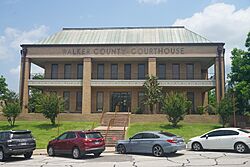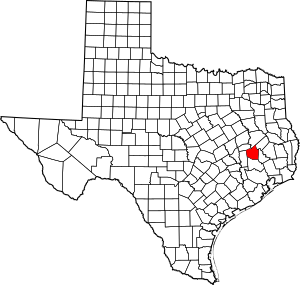Walker County, Texas facts for kids
Quick facts for kids
Walker County
|
|
|---|---|

The Walker County Courthouse in 2022
|
|

Location within the U.S. state of Texas
|
|
 Texas's location within the U.S. |
|
| Country | |
| State | |
| Founded | 1846 |
| Named for | Robert J. Walker, Renamed for Samuel H. Walker |
| Seat | Huntsville |
| Largest city | Huntsville |
| Area | |
| • Total | 802 sq mi (2,080 km2) |
| • Land | 784 sq mi (2,030 km2) |
| • Water | 17 sq mi (40 km2) 2.2% |
| Population
(2020)
|
|
| • Total | 76,400 |
| • Density | 95.26/sq mi (36.78/km2) |
| Time zone | UTC−6 (Central) |
| • Summer (DST) | UTC−5 (CDT) |
| Congressional districts | 8th, 17th |
Walker County is a special area called a county in the central part of Texas, a state in the United States. In 2020, about 76,400 people lived here. The main town and where the county government is located is Huntsville.
Walker County was first named after Robert J. Walker. He was a politician from Mississippi who helped Texas join the U.S. Later, he supported the U.S. during the Civil War, which made some people unhappy. To keep the county's name, it was then renamed after Samuel H. Walker. He was a brave Texas Ranger and soldier, and he was not related to Robert J. Walker.
Walker County is part of the Huntsville area, which is also connected to the larger Houston-The Woodlands area.
Contents
Exploring Walker County's Geography
Land and Water Areas
Walker County covers a total area of 802 square miles. Most of this, about 784 square miles, is land. The remaining 17 square miles, which is about 2.2% of the county, is covered by water.
Main Roads and Highways
You can travel through Walker County using several important roads:
 Interstate 45
Interstate 45 U.S. Highway 190
U.S. Highway 190 State Highway 19
State Highway 19 State Highway 30
State Highway 30 State Highway 75
State Highway 75 State Highway 150
State Highway 150
Neighboring Counties
Walker County shares its borders with several other counties:
- Houston County to the north
- Trinity County to the northeast
- San Jacinto County to the east
- Montgomery County to the south
- Grimes County to the west
- Madison County to the northwest
Protected Natural Areas
Part of the Sam Houston National Forest is located within Walker County. This is a large area of trees and nature that is protected.
Walker County's Population Story
How Many People Live Here?
The number of people living in Walker County has grown over many years. This information comes from the U.S. Census, which counts everyone in the country every ten years.
| Historical population | |||
|---|---|---|---|
| Census | Pop. | %± | |
| 1850 | 3,964 | — | |
| 1860 | 8,191 | 106.6% | |
| 1870 | 9,766 | 19.2% | |
| 1880 | 12,024 | 23.1% | |
| 1890 | 12,874 | 7.1% | |
| 1900 | 15,813 | 22.8% | |
| 1910 | 16,061 | 1.6% | |
| 1920 | 18,556 | 15.5% | |
| 1930 | 18,528 | −0.2% | |
| 1940 | 19,868 | 7.2% | |
| 1950 | 20,163 | 1.5% | |
| 1960 | 21,475 | 6.5% | |
| 1970 | 27,680 | 28.9% | |
| 1980 | 41,789 | 51.0% | |
| 1990 | 50,917 | 21.8% | |
| 2000 | 61,758 | 21.3% | |
| 2010 | 67,861 | 9.9% | |
| 2020 | 76,400 | 12.6% | |
| U.S. Decennial Census 1850–2010 2010–2020 |
|||
Different Backgrounds in Walker County
People from many different backgrounds live in Walker County. The table below shows the mix of races and ethnic groups over the years, based on the U.S. Census.
| Race / Ethnicity (NH = Non-Hispanic) | Pop 2000 | Pop 2010 | Pop 2020 | % 2000 | % 2010 | % 2020 |
|---|---|---|---|---|---|---|
| White alone (NH) | 37,090 | 39,671 | 39,823 | 60.06% | 58.46% | 52.12% |
| Black or African American alone (NH) | 14,672 | 15,098 | 16,382 | 23.76% | 22.25% | 21.44% |
| Native American or Alaska Native alone (NH) | 169 | 186 | 251 | 0.27% | 0.27% | 0.33% |
| Asian alone (NH) | 464 | 617 | 1,126 | 0.75% | 0.91% | 1.47% |
| Pacific Islander alone (NH) | 25 | 19 | 39 | 0.04% | 0.03% | 0.05% |
| Other Race alone (NH) | 70 | 72 | 318 | 0.11% | 0.11% | 0.42% |
| Mixed Race or Multiracial (NH) | 556 | 809 | 1,883 | 0.90% | 1.19% | 2.46% |
| Hispanic or Latino (any race) | 8,712 | 11,389 | 16,578 | 14.11% | 16.78% | 21.70% |
| Total | 61,758 | 67,861 | 76,400 | 100.00% | 100.00% | 100.00% |
In 2000, there were 61,758 people living in the county. About 78 people lived in each square mile. There were 18,303 households, which are groups of people living together in a home. Many of these households (28.70%) had children under 18. About 46.80% were married couples.
The population was spread out by age. About 18% were under 18 years old. A large group, 23%, were young adults aged 18 to 24. The median age was 31 years old, meaning half the people were younger than 31 and half were older.
Education in Walker County
Universities and Colleges
Sam Houston State University is a big university located in Huntsville. It offers many different study programs.
Different parts of Walker County are served by various colleges:
- Areas within Huntsville and New Waverly school districts are part of Lone Star College.
- Parts of Walker County in the Trinity school district are connected to Angelina College.
- The portion of Richards school district in Walker County is linked to Blinn College.
Local School Districts
Several school districts serve the children and teens in Walker County:
- Huntsville Independent School District
- New Waverly Independent School District
- Richards Independent School District (part of it)
- Trinity Independent School District (part of it)
There is also a special school called the Gulf Coast Trades Center. It's a charter school located in an area of the county that isn't part of a city.
Communities in Walker County
Cities to Explore
- Huntsville (This is the main city and where the county government is located.)
- New Waverly
- Riverside
Small Towns and Areas
- Dodge (This is a smaller community that is not officially a city.)
Famous People from Walker County
- Eugene C. Barker
- Marilyn McAdams Sibley
- Sherri Ann Jarvis, a teenager whose identity was unknown for a long time after her death in 1980.
- Slater Martin, a well-known basketball player.
See also
 In Spanish: Condado de Walker (Texas) para niños
In Spanish: Condado de Walker (Texas) para niños

